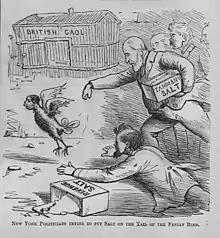Salting a bird's tail
Salting a bird's tail is a legendary superstition of Europe and America, and an English language idiom. The superstition is that sprinkling salt on a bird's tail will render the bird temporarily unable to fly, enabling its capture.

The nursery rhyme Simple Simon, which dates to at least the 17th century and possibly earlier, includes the verse
He went to catch a dicky bird,
And thought he could not fail,
Because he had a little salt,
To put upon its tail.[1][2]
The belief itself is documented to the 16th century, and may be older.[3] Found in European countries such as Sweden,[4] it also crossed the ocean to North America.[5] It is generally told to children,[6][7] and not commonly believed anymore by adults. In the verse in Simple Simon (above), the point is made even then only a simpleton would believe the legend.

Salting of a bird's tail has been used by analogy as an idiom for immobilization of persons since at least the 19th century, by writers such as Walter Scott,[3] Robert Burns,[2] Walter Lantz,[8] and John Phillips with his song, “No Salt On Her Tail” preformed by The Mamas and The Papas. Other examples include "Ye'll ne'er cast saut on his tail" (English: You'll never cast salt on his tail) is a Scottish proverb of unknown antiquity.[9]
References
- "Simple Simon". Ingeb.com. Retrieved June 28, 2020.
- Alker, Sharon; Davis, Leith (2012). Nelson, Holly Faith (ed.). Robert Burns and Transatlantic Culture. Ashgate Series in Nineteenth-Century Transatlantic Studies. Ashgate. pp. 171–172. ISBN 978-1409405764. Retrieved June 28, 2020.
- Farmer, John Stephen; Henley, W. E., eds. (1903). Slang And Its Analogues. Vol. VI. Printed for subscribers only. pp. 60, 97. Retrieved June 28, 2020.
- Anna Wahlenberg, Anna (1973). "The Magpie with Salt on her Tail". In Olenius, Elsa (ed.). Great Swedish Fairy Tales. Translated by Lundbergh, Holder. Delacorte Press / Seymour Lawrence. p. 136. ISBN 978-0440030416.
- Hand, Wayland, ed. (1964). Popular Beliefs And Superstitions From North Carolina. The Frank C. Brown Collection of North Carolina Folklore. Vol. 7. Duke University Press. p. 390. ISBN 0822302594.
- "Salting a Bird's Tail — Fact or Folklore?". Farmer's Almanac. February 23, 2009. Retrieved June 28, 2020.
- Matthew Chatfield (November 25, 2006). "Laying salt on a pigeon's tail". Naturenet. Retrieved June 28, 2020.
- McCall, Douglas L. (1998). Film Cartoons: A Guide to 20th Century American Animated Features and Shorts. McFarland Publishing. p. 154. ISBN 978-0786405848. Retrieved July 31, 2020.
- Hislop, Alexander (1868). The Proverbs of Scotland. Edinburgh: Alexander Hislop & Company. p. 325. ISBN 978-1113457684. Retrieved July 28, 2020.Mackay, Charles (1888). A Dictionary of Lowland Scots. Boston: Ticknor & Company. p. 380. ISBN 978-1112458590. Retrieved July 4, 2023.